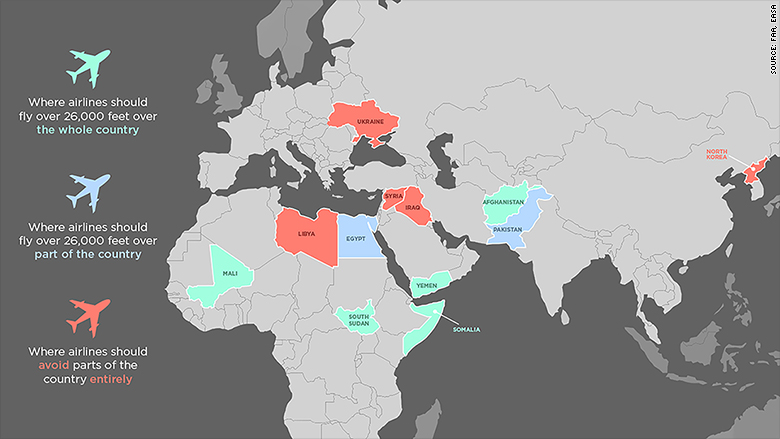
Is it safe to fly over war zones? And if so, how low can you go?
Saturday's plane crash over Egypt has once again sparked questions about flight paths that cross hostile regions.
The plane's Russian operator said Monday that the only reasonable explanation for the crash was a "certain influence, a technical [and/or] mechanical impact on the vessel." The initial view of U.S. intelligence and defense officials is that there's no evidence yet of a missile or external event bringing down the aircraft.
Still, some airlines are now avoiding the Sinai region of Egypt, where ISIS-affiliated militants have been battling Egyptian security forces for the last few years.
Air France (AFLYY), KLM, Lufthansa (DLAKY), Emirates, Qatar Airways, Air Arabia, Etihad and flydubai have recently opted to reroute their flights to circumvent the area.
The European Aviation Safety Agency issued guidance for the region a year ago, when it warned civilian aircraft operators about a "significant risk" due to "ongoing insurgent activity" in North Sinai, and told airlines to not fly below 26,000 feet.
The Federal Aviation Administration, which controls U.S. airlines, issued similar guidance in March.
But Metrojet Flight 9268 was flying above 30,000 feet when it disappeared from radar screens after taking off from the Egyptian resort town Sharm el-Sheikh.
The Airbus A321-200 broke into pieces before it hit the ground, killing all 224 people on board.
Related: How safe are European airlines?
The list of no-fly zones is growing as the conflict in the Middle East escalates. U.S. airlines have been ordered not to fly over Iraq and Syria since August 2014.
The European Aviation Safety Agency is less strict -- rather than prohibiting airlines from flying certain routes, it issues guidance on safety and leaves the power to ban certain regions to national authorities. It recently warned of the risks posed by low-flying missiles over Iran and Iraq.
But the agency did not make any recommendations about whether pilots should revise their routes, saying the missiles were launched well below the airspace where commercial carriers usually fly.
Air France responded by introducing temporary rules for flights heading over Iraq and Iran, but German airline Lufthansa said it wouldn't make any changes.
The European Aviation Safety Agency has also warned all airlines that they should remain above 26,000 feet over Afghanistan, Yemen, Somalia and parts of Pakistan. The U.S. added Mali and South Sudan to the list.
And since a missile downed flight MH17 over eastern Ukraine last year, authorities in Europe and U.S. have ruled that some parts of the country are off limits altogether. North Korea and parts of Libya are also no-go areas for U.S. airlines.
